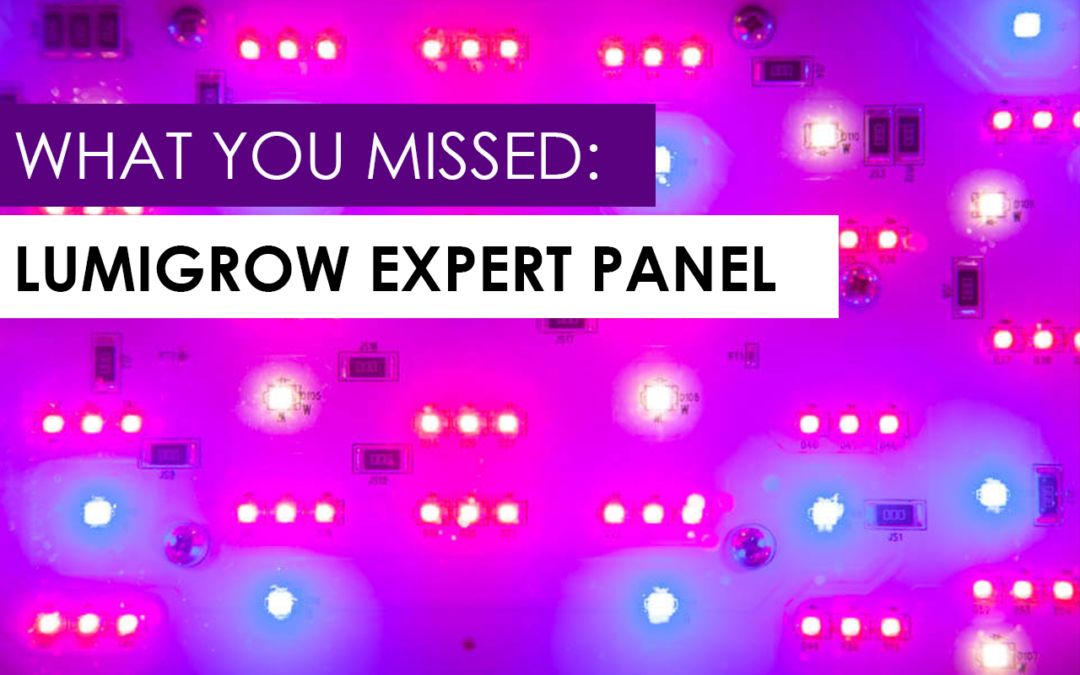As a grower, you know how incredibly important it is to have proper lighting for healthy, strong plants. Recently, we hosted a live presentation and Q&A session with LumiGrow to address the specific lighting needs for different kinds of plants.This post provides a summary of what was covered during the live event.
LumiGrow, Inc. is a leader in smart horticultural lighting. They empower growers and scientists with the ability to improve plant growth, boost crop yields, and achieve cost-saving operational efficiencies. LumiGrow offers a range of proven grow light solutions for use in greenhouses, controlled environment agriculture, and research chambers.
Joining us from LumiGrow to talk about lighting solutions is Dr. Melanie Yelton, VP of Research; Jake Holley, Senior Research Associate; and Brandon Newkirk, Marketing Communications Manager.

Growers can use adjustable LEDs to achieve an extremely high level of control over their crops. This kind of control is exciting in controlled-environment agriculture; you can accelerate slow plant growth, direct plant morphology, elicit bigger yields, improve quality, lengthen shelf life, create differences in flavor profiles, and mitigate plant growth hormones.
Introduction to horticultural lighting
This section will cover a brief overview of horticultural lighting solutions. We will quickly go over what horticultural lighting is, and how it can be used to manipulate crop characteristics.
Like anything else, it’s important to identify what you would like to achieve with lighting from the get-go.
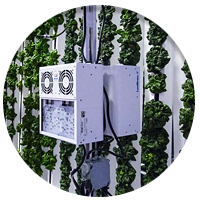 Consider your own goals:
Consider your own goals:
- Growth environment
- Production season
- Crop varieties
- What market you’re addressing
In order to understand some of the lighting terms presented in this material, it may be helpful to learn some quick definitions.
The researchers at LumiGrow talk about light in terms of a unit called DLI. DLI is an acronym for Daily Light Integral, and is a function of photosynthetic light intensity and duration. It is usually expressed as moles of light per square meter per day. A general DLI range for greenhouses is between 5 mols/day, and 25 mols/day, however, anything under 10 mols/day is going to be insufficient for good crop growth. Anything above 20 mols/day will generally produce good results. The important thing is that this is a measure of how much light your plants receive in a day rather than how much light they receive at any specific moment in time.
For more information on light and lighting terms, check out Upstart University course “Lighting for Upstart Farmers.”
Now that you understand how light is measured and discussed for the context of this post, let’s take a look at lighting for specific crops, starting with tomatoes.
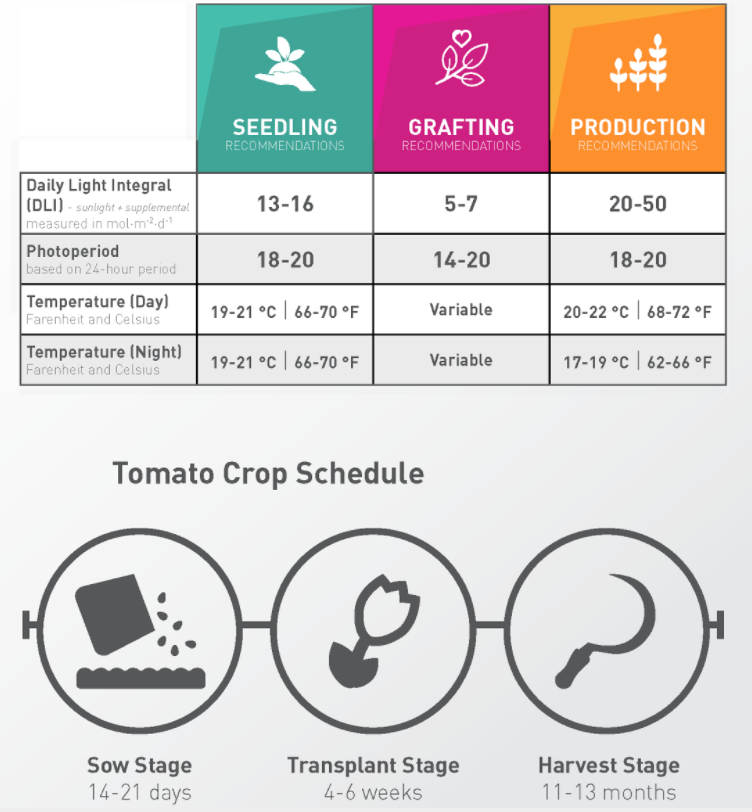
Tomatoes
Tomatoes are the most popularly grown greenhouse crop in North America.
Growing season with LEDs: Year round
Growing season without LEDs: November–March
Amount of light (DLI) per stage:
- Seedling: 13–16 mols/day
- Grafting/transplanting: 5–7 mols/day
- Production: 20–50 mols/day
Special LED considerations:
↑ Increase in Red, ↓ decrease in Blue: More stretching in plants
↑ Increase in Blue, ↓ decrease in Red: More compact plants.
You can use these ratios to ensure that you’ll always have the same sized plant, and to ensure good grafting. In grafting especially, using more blue and keeping the plants compact is good for the healing of the plants. In production, higher amounts of red with a good amount of blue to maintain plant health can really drive good productivity, flavor, and shelf life.
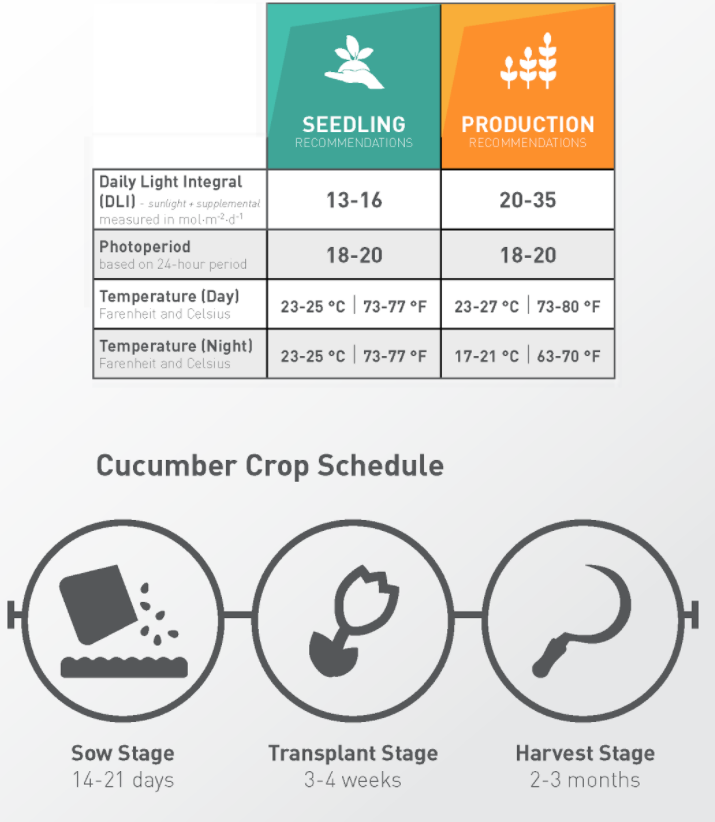 Cucumbers
Cucumbers
Cucumbers react differently to light than tomatoes, and aren’t usually grafted.
Amount of light (DLI) per stage:
- Seedling: 13–16 mols/day
- Production: 20–35 mols/day
Special LED Considerations:
Cucumbers are not as light hungry as tomatoes; they don’t require they same high amounts of overall lighting.
However, under LEDs, cucumbers can be grown with fuller leaves, deeper color, and good yield.
Cucumbers are especially sensitive to the toggling of spectra in order to manipulate the type of growth: vegetative, or flowering and reproductive. Some people even say that LEDs give cucumber a better crunch! More than just a texture preference, statements like these are pretty good indications of an increase in quality.
Peppers
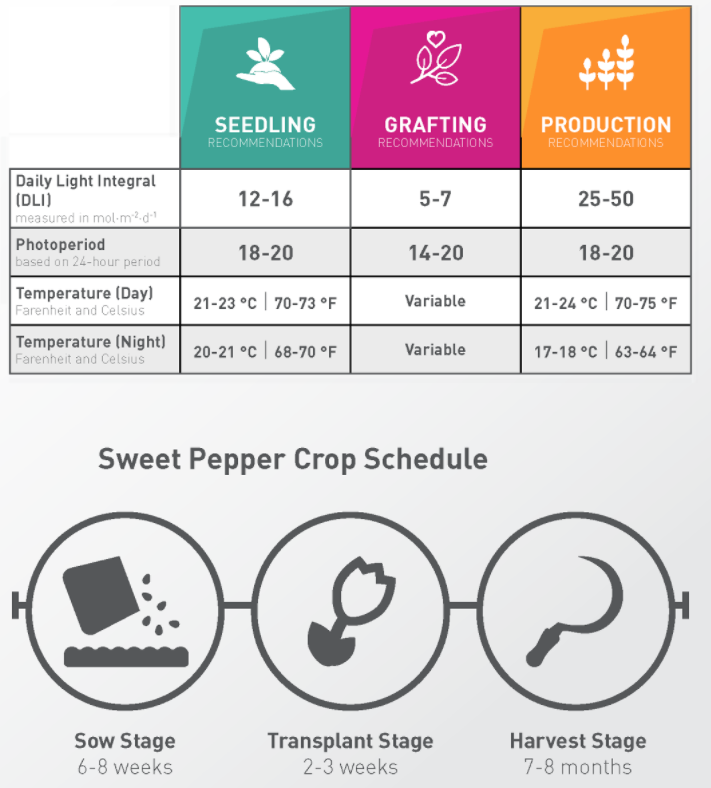
Peppers are a newer crop to supplemental lighting, and have a higher light requirement than cucumbers.
Amount of light (DLI) per stage:
- Seedling: 12–16 mols/day
- Grafting/transplanting: 5–7 mols/day
- Production: 25–50 mols/day
The research is rather encouraging. By using the LEDs, the results are presenting thick fruit walls, and large fruit set—up to eight peppers on a vine.
Other Crops
Lettuce
From a research standpoint, leafy greens are a rather uncomplicated model to work with in comparison to the vine crops. This is because in place of focusing on the fruit of the crop, we are eating the vegetation, or the leaves themselves.
Amount of light (DLI) per stage:
- Youth: 22 mols/day
- Maturity: 17 mols/day
Special LED Considerations:
↑ Increase in Red, ↓ decrease in Blue: Sweeter taste
↑ Increase in Blue, ↓ decrease in Red: Spicier, richer taste. If added in the last few days, it also enhances color.
When greens are young and the transportation rates are higher in the plant, they can take higher amounts of light. As the plants get bigger, problems like calcium tip burn arise, and the plant needs less light.
Microgreens
For those of you interested in eliciting the beneficial characteristics of plants by using lighting strategies, microgreens is a great place to start. Because they have such short growth cycles, you’ll be able to go through many trials and dial in the lighting strategy for your specific goals.
According to LumiGrow’s research, microgreens are similar to lettuce, but with a shorter cycle. Increasing blue light in the last couple of days will enhance flavor, color, and nutrition.
Herbs
Herbs can take higher levels of supplemental or natural lighting, and can be pushed a little bit harder than the lettuces and microgreens. Herbs generally prefer a DLI of around 15–20 DLI for production, though it will vary by species.
Basil has provided some suggestions, and even evidence, that LEDs can aid in preventing disease, and prolonging shelf life. Some of this evidence came from looking at basil downy mildew. Use of LEDs saw a reduced infection capability of this particular fungal disease. Reduced disease and prolonged shelf life seem to be unexpected benefits of growing with LEDs.
Q&A
During the live event, we opened up the discussion to questions from listeners, ranging from light-specific, to LumiGrow products. Here’s what was addressed:
“Can you give more details about light spectrum for lettuce and how the spectrum has to be changed from seedling to harvest?”
In general, what we see between the seedling stage and 2 or 3 weeks into production is that it is most important to build leaf area and biomass. So at that point, higher red spectrum tends to be a little bit more photosynthetically efficient and better at building larger and wider leaves. This should be more red, not entirely red because a little bit of blue is always necessary to maintain good plant health.
Then, as the plant gets closer to harvest, some of the deep coloration and secondary metabolite production that’s important will be brought out by a spectrum that is a little heavier blue.
That is generally the switch: a DLI that is a little higher and more red-heavy, to a little bit lower of a DLI that is more blue-heavy. This shift could take place anywhere from the last two weeks of production to the last three days.
“Is there a relationship between spectrum and distance from the plants?”
Depending on who manufactures your LEDs, 15 inches is probably a safe distance. LEDs all have a cap lense that spreads the light, so you’ll want to make sure that you’re getting adequate mixing of spectra. In general, the spectral profile in terms of color ratios won’t change depending on distance, however, the intensity will. There is software out there that will calculate what the ideal distance is based on what you’re using for lighting.
“How many spectral peaks is enough for most applications? I know that you need more than just one red peak and one blue peak, but what other peaks do you need?”
The wavelengths that are the most important and valuable to successful plant growth are between 400 and 700 nanometers.
It isn’t as necessary to have specific peaks, so to speak, as it is to cover the spectrum at least to a certain extent. We know that red and blue are the most influential for maintaining plant health, but we’re also starting to find out that having green spectrums is important. However, it doesn’t necessarily have to be a peak—a broad spectrum can be as useful in certain applications. The amounts also do not have to be that high in order to get the responses you need.
You can use those peaks to direct plant growth, but include enough light for the important plant signaling processes as well.
“Can you speak to the business case for smart lighting? When does it make sense to invest in smart lighting versus at what scale does it not make sense?”
With greenhouse production, smart lighting can provide consistency. This can mean having a consistent product everyday, and it can also mean being able to plan ahead in your operation.
Smart lighting also makes you fairly adaptable to changes in the not-so-reliable sun’s patterns.
Choosing smart lighting will be a decision that involves just about every aspect of your farming operation and your production goals, so make sure to have that stuff nailed down as much as possible. When you get a light plan with us, we run an ROI calculation, and we let you know what your payback periods are.
Smart lighting is also a really great tool for having multiple species in your greenhouse; you can create different zones depending on what needs how much light.
“Will the LumiGrow lights integrate with LASSI (Lighting and Shade System Implementation)?”
LASSI is an algorithm developed at Cornell, and runs a program that is used to hit your ideal light goals very precisely while saving energy. It was originally developed to be used with high pressure sodium lighting, so in it’s traditional sense, yes, these lights will integrate into that performance platform. However, LumiGrow has a design that can do better and adjust their lights on a minute-by-minute basis. They are working to develop control algorithms that include spectral response and ambient light levels to be incorporated into the light fixtures. This means that because LEDs don’t have the same sensitivity to being turned on and off too much, they can be much more easily adjusted to respond to the sun’s light levels.
“Does your smartPAR wireless control system work with other lighting products?”
Right now it is proprietary to LumiGrow, and only works with their Pro Series E and Pro Series fixtures.
“Does the LumiGrow Pro Series offer variable ratios of spectra?”
Of course. You can adjust to any ratio that you want: all blue, all red, etc. It is very dynamic and you can dial in exactly what you need.
“Are the LumiGrows controlled by PWM (pulse width modulation)?”
The LumiGrow fixtures are controlled by differences in current. So instead of pulse width modulation, they’re changing the overall amount of power that is flowing through the fixtures at any given time. If you look at the Hertz breakdown, they never change; what changes is the amplitude of those signals.
About LumiGrow
 LumiGrow has been a pioneer for smart horticultural lighting for the past 10 years. They provide a uniquely modern lighting solution; growers use the adjustable LEDs in conjunction with the smartPAR wireless control system to elicit beneficial crop characteristics using spectrum period and intensity.
LumiGrow has been a pioneer for smart horticultural lighting for the past 10 years. They provide a uniquely modern lighting solution; growers use the adjustable LEDs in conjunction with the smartPAR wireless control system to elicit beneficial crop characteristics using spectrum period and intensity.
LumiGrow offers an LED Grower’s Guide for Vine Crops that walks you through lighting requirements and how to direct crop growth with light.
If you’re interested in getting more information, go to www.lumigrow.com.
They have also just released the smartPAR light sensor module. This is the first of its kind, and it integrates with the smartPAR wireless control system and measures the ambient sunlight within a grow facility.
If you have additional questions, feel free to reach out to us here on Upstart University or to LumiGrow to get them answered!

